Here's a concept from Soviet past. ~3 octaves in the left, ~3 octaves free bass in the right. I believe it had a catchy name of "Semi-Bayan".
If this was a high quality box with good reeds (2 voices in unison) and 5-row keyboards, I think it would be a winner. Perhaps, only 1 voice in the left hand side, but stick it in cassotto. Perhaps, Moschino in the left hand side (I'm still working towards this one).
I agree on the big boxes - they are way too bulky & heavy, and I don't have any bats in my family, so really don't need the ultrasound octaves. The lowest free bass octave sounds OK, but I can't see it being used very often, so that can be left out too. I think the accordion reed performs well in the middle. If you have C2-C5 in the LHS and C3-C6 in the RHS, that gives you a huge range - way more than most other musical instruments.
...Yep, I've started drafting a design of my dream acoustic accordion...
...I even tried making some reeds by hand with reasonable success (at this point, purely for educational purposes)...
But the build won't be happening any time soon, if ever.
I recently bought something similar from a secondhand dealer in the Ukraine.
It was packaged remarkably well and arrived in good condition and well tuned.
I now have to prise it back out of my music teacher's hands!!
https://www.etsy.com/au/shop/MarketFleaShop if anyone is interested.




